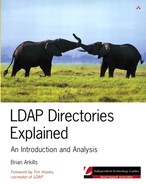Lightweight Directory Access Protocol (LDAP) is the predominant protocol used to communicate with directories. These days, directories are everywhere. Many enterprise software packages require a directory, for example, and companies seeking to reduce costs and streamline their business also implement a directory.
Not so long ago, I knew nothing about LDAP. Because Stanford University, my employer, was implementing and integrating Active Directory with its existing directory, I needed to understand LDAP and how directories worked. However, I found that the resources for a novice were sparse and hard to find, and that none of the books on the subject took me from novice to competency. During the course of the Stanford project, I met David Chappell and worked closely with him. This led to an invitation from Addison-Wesley, and I embarked on writing this book. I hope it fills the gap I found.
This book is part of the Independent Technology Guide series, which focuses on providing an independent look at a technology combined with a no-nonsense approach. David Chappell, the series editor, likes to say that the series should be called “Big Pictures 'R' Us.” Each of the books in the series explains how the technology fits into the larger world. Technical managers turn to this series for explanations of all the acronyms and buzzwords they hear.
This book is also appropriate for someone who is more technically savvy, but looking to break into LDAP and directories. Almost every LDAP book on the market is written for developers, and those who don't write code are left in the dark. This book takes a different approach by providing a thorough introduction for newcomers regardless of their orientation or technical background. Once you've finished this book, you might turn to Understanding and Deploying LDAP Directory Services by Tim Howes, Mark Smith, and Gordon Good to continue learning about LDAP, especially in the context of developing LDAP code.
The book is divided into two parts. Part I explores how LDAP and directories work in general. This book is unique in its approach to the topic from a standards-based, non-product-centric perspective. Part II explores three products to highlight how LDAP is used. If you don't have a lot of time to do research, this overview of the most popular LDAP products will help you compare existing products.
There are also several appendixes to augment the material presented in the chapters. When additional material is available, I have included references in the relevant chapter. I'd like to call your attention to two of the appendixes in particular. Appendix C is a case study of Stanford University's directory architecture. It is intended to give you a real-world sense of how integral an LDAP directory can become to your business. Appendix G contains URLs for all the online reference material that I used while writing this book. Many people have indicated to me how invaluable this compilation of online resources was to their research.
Brian Arkills, October 2002
